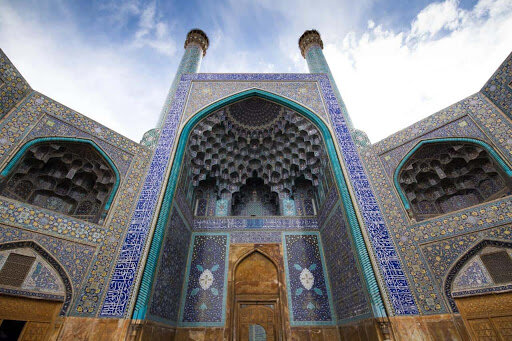

TEHRAN – At the southern end of the UNESCO-registered Imam (Naghsh-e Jahan) Square stands the big, grand, and imposing Imam Mosque in the touristic city of Isfahan, central Iran.
Visitors to the mosque are mainly overwhelmed with good views of the main dome with its glorious profusion of turquoise-shaded tiles as one of the masterpices of the Islamic architecture.
Originally named Masjed Shah (“the Shah Mosque”), its construction began in 1611 during the rule of the Safavid King Shah Abbas the Great who reigned from 1588 to 1629. The mosque’s topmost dome was completed in the last year of his sovereignty.
The monument is not only impressive because of its sheer size and incredible decorations but also helps to get a good impression of the needs and challenges of always on-going restoration works.
The craftsmanship continues and is intricate with amazing views both on the façade and the interior. The monument boasts perfect proportions and iconic blue-tiled mosaics.
A very picturesque huge entrance portal welcomes people to the mosque. It is built to face the square though the mosque is oriented towards Mecca. A short corridor connects the square to the inner courtyard that is surrounded by four imposing iwans (porticos) with a pool dedicated to ritual ablutions nesting in the middle.
The walls of the courtyard feature sunken porches framed by seven-colored tiles of deep blue and yellow. Each iwan leads into a vaulted sanctuary covered with particularly fine floral motifs on a blue background.
Many believe each of the mosque’s parts is a masterpiece that leaves a lasting impression. This palace of devotion owes its splendor mostly due to being covered with seven-color mosaic tiles and symmetrical calligraphic inscriptions.
On the other side of the square stands the very delicate Sheikh Lotfollah Mosque which was dedicated to the ruler’s father-in-law, Sheikh Lotfollah, a revered Lebanese scholar of Islam who was invited to oversee the construction of the Shah Mosque.
The mosque’s interior and exterior walls are fully covered with a polychrome, mostly dark blue, glazed tile revetment above a continuous marble dado. Throughout the whole mosque, except for the sanctuary dome and portal iwan, Shah ‘Abbas was keen to minimize labor costs and time by introducing a novel technique called “haft-rangi” (seven colors).
Isfahan has long been nicknamed as Nesf-e-Jahan which is translated into “half the world”; meaning seeing it is relevant to see the whole world. The city is home to many versatile artisans who underpin its reputation as a living museum of traditional culture.
AFM/
Related posts:
Views: 0
 RSS Feed
RSS Feed

















 February 9th, 2021
February 9th, 2021  Awake Goy
Awake Goy  Posted in
Posted in  Tags:
Tags: 
















